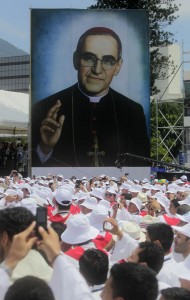
By Rhina Guidos
Some thought this day would never arrive. Others hoped, and some always knew it would.
Archbishop Oscar Arnulfo Romero y Galdamez, of El Salvador, who was assassinated in 1980 while celebrating Mass just a day after pleading and ordering soldiers to stop killing innocent civilians, was beatified on May 23.
“Blessed Romero is another brilliant star that belongs to the sanctity of the Church of the Americas,” said Cardinal Angelo Amato, head of the Vatican’s Congregation for Saints’ Causes, during the ceremony that took place in San Salvador.
While those who persecuted him have died or are in obscurity, “the memory of Romero continues to live in the poor and the marginalised,” Cardinal Amato said.
His homilies often pleaded for better conditions for the poor, for a stop to the escalating violence in the country and for brotherhood among those whose divisions ultimately led to a 12-year conflict.
In a message sent on 23 May, on the occasion of the beatification, Pope Francis said that Archbishop Romero “built the peace with the power of love, gave testimony of the faith with his life”.
Proof of that is the shirt he died in, soaked in blood after an assassin’s single bullet took his life. Eight deacons carried the blood-stained shirt, now a relic, to the altar in a glass case.
In a time of difficulty in El Salvador, Archbishop Romero knew “how to guide, defend and protect his flock, remaining faithful to the Gospel and in communion with the whole Church”, the Pope said in his message.
“His ministry was distinguished by a particular attention to the poor and marginalised.
“And, at the time of his death, while celebrating the holy sacrifice, love and reconciliation, he received the grace to be fully identified with the one who gave His life for His sheep.”
But just as he has devotees, Archbishop Romero also has had detractors.
After his death, the Vatican received mounds of letters against Archbishop Romero, Archbishop Paglia has said. And that affected his path toward sainthood, which includes beatification. But, three decades after his assassination, Pope Benedict XVI cleared the Archbishop’s sainthood cause.
In February, Pope Francis signed the decree recognising (now Blessed) Archbishop Romero as a martyr, a person killed “in hatred of the faith”, which meant there is no need to prove a miracle for beatification. In general, two miracles are needed for sainthood – one for beatification and the second for canonisation.
Father Turcios, pastor of El Salvador’s St Anthony of Padua Catholic Church in Soyapango and national director of the Pontifical Mission Societies in El Salvador, said that, by studying Blessed Romero’s life, others will discover all the Gospel truths that led him to defend life, the poor and the Church, and do away with untruths surrounding his legacy.
During the country’s civil war, that lasted from 1979 until 1992, some Salvadorans hid, buried and sometimes burned photos they had taken with or of Archbishop Romero because it could mean others would call them communists or rebel sympathisers, and put their lives in danger.
Though he still has some detractors, Fr Turcios said, the beatification can help others understand the reality and truth that others have known all along: Archbishop Romero “was loyal to God’s will, was loyal to and loved his people and was loyal to and loved the Church”, he said.
Priests, bishops and cardinals wore some form of a red vestment, signifying martyrdom.
Their stoles were emblazoned with Archbishop Romero’s episcopal motto: Sentir con la iglesia, or “feel with the Church”, also translated as “to think with the Church”.
The ceremony concluded a week in San Salvador that saw pilgrims, mainly from Latin America, but also from as far away as Singapore and many from the United States, who wanted to celebrate the occasion. – CNS